Turning can be dangerous, because it usually means you have to cross the path of other vehicles and must give way to them if they are not turning.
When a large rigid vehicle is turning the rear wheels may follow a shorter path than the front wheels. This is called the ‘swept path’.
Heavy rigid vehicles can have a large rear overhang. This means the rear of the vehicle will swing out away from the direction of the turn.
To legally and safely make a left or right turn:
If you are turning left, use your left indicator. If you are turning right, use your right indicator.
Be prepared to stop, even if the other driver should give way to you.
If you are driving out of a driveway:
If you are turning left into another street or driveway:
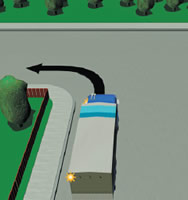
Left turn
In this situation:
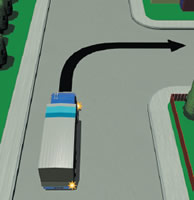
Right turn on an unlaned road
In this situation:
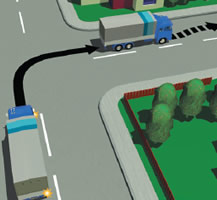
Right turn on a road with a centre line
ImportantYou should move into a similar position on the road you’re turning into, to your position on the road you’ve just left. For example, if you are on the left-hand side of the road, you should stay on the left-hand side of the road after you’ve turned; or if you are in a lane next to the centre line, you should turn into the lane next to the centre line. |
If there are other vehicles moving fast or following too closely, or if the road is narrow, it may be best to wait on the left-hand side of the road to make the turn, rather than stopping in the middle of the road and holding up traffic. In this situation:
If a vehicle in front of you has also stopped to turn right, it’s best to wait behind them and then use the same position to turn from.
Take extra care on roads where the traffic is moving quickly.
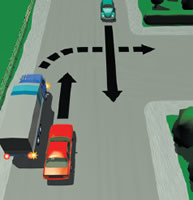
Turning right from the left-hand side of an unlaned road
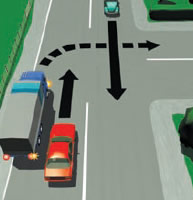
Turning right from the left-hand side with a centre line
Safety tipMoving to the left is not always an option and can be dangerous. |
A right-turn bay is an area where vehicles that are turning right can wait until it is safe to turn, without holding up vehicles going straight through.
You don’t use the right-turn bay to overtake a vehicle travelling straight ahead.
As you approach the right-turn bay, the road will be painted with a white triangle with diagonal lines inside it, followed by one or more right-turn arrows.
You can only drive over the white diagonal lines if you are turning right.
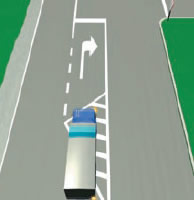
Right-turn bay
A flush median is a strip in the centre of the road that is marked with white diagonal lines within parallel lines. It provides a place for vehicles that are turning right or vehicles that have turned right onto the road from a side road or driveway.
You can only drive onto the flush median to:
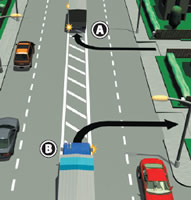
Using a flush median
ImportantWhen using a flush median, watch out for pedestrians who might be waiting on the flush median to cross the road. |
You are normally allowed to make U-turns, as long as the road is clear in both directions and it is safe to do so. A heavy vehicle will have a larger turning circle than a car so make sure the road is wide enough for you to make the turn.
In a tight turn the tyres on multiple axles can damage the road surface so take care. Do not hit the kerb with the sidewall of the tyre as this will damage the tyre.
You aren’t allowed to make U-turns on a motorway or if a No U-turn sign is displayed.
You can cross over the solid yellow no-passing line (if it is safe to do so) when making a turn to enter a driveway or side road.
However, bear in mind that no-passing lines are usually marked where visibility is limited, so special care is required. It may be safer to turn further along the road, where visibility is better.